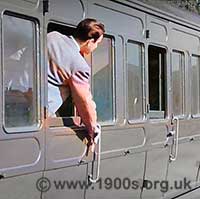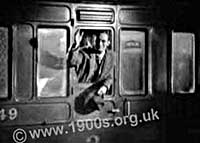Opening windows on early UK trains

Windows actually opened on old trains: not the tiny fanlight ones of today, but full-sized ones in the doors that passengers could lean out of. This page explains how these windows opened and locked in position, and it describes the implications of soot, grime, draughts, safety and danger. Highlights are firsthand recollections.
____
By the webmaster based on her early recollections with additional research and firsthand contributions
What I remember particularly about travelling by train in the 1940s and 1950s was the windows. They had probably changed little since the early days of the railways, but that of course was outside my personal experience. It was the ones in the train doors that opened and it was common practice to lean out of them, particularly when waving goodbye to people on the platform - this in spite of the notices telling passengers not to lean out of the window. Today, of course, safety requires that large train windows - and doors - are locked shut while trains are moving, but at the time it was necessary for windows to open for ventilation.

Open window in a typical 1940s train door.* The green walls were due to the whole carriage being the dining car. Normal compartments had the same windows and non-descript colour walls.

Waving goodbye through an open train window in the 1940s
How train windows opened and closed
Windows could be raised and lowered with a leather strap and held in position by locking one of the holes in the strap over a metal stud. The arrangement is shown in the first of the above photos. It took quite a lot of strength to lift the strap off its stud to move it.
The danger of leaning out of the window
There were notices pointing out that it was dangerous to lean out of the window while the train was moving, but it didn't stop anyone. We all seemed to think that we would spot a train coming in the opposite direction or a bridge approaching and dodge back inside quickly. This normally worked, but there were cases of people being decapitated when leaning out of train windows.
The enjoyment of leaning out of the window
Leaning out of a train window of a moving train was a particularly enjoyable experience for children: to feel the wind rushing into one's face and through one's hair and to see the engine belching out smoke as the train rounded a bend.
The annoyance of leaning out of the window
A particular problem with leaning out of a train window was the smoke from the engine. It was sooty from the partly burnt coal: it got into eyes and made faces black, even if the leaning out was only for a few moments. There was also the occasional spark which was painful.

The cloud of sooty smoke from the engine of a steam train (ex-LNER B1 class engine) courtesy of John Axtell who took the photograph on a heritage railway day.

The stream of sooty smoke from the engine of a steam train which wafted along the whole length of the train - with acknowledgements to the Steam Museum at Swindon.
So children were encouraged to 'stay inside' when out visiting; otherwise there was a quick lick and a promise from mother's handkerchief at the end of the journey.
Should the train windows be open or closed?
Irrespective of whether anyone was leaning out of the window, it was not always easy to get agreement among the passengers about how far the window should be pulled down. It could be too draughty and dirty for passengers sitting facing the direction of travel, but not for the passengers on the opposite side.
Train window protection in WW2
Although I clearly remember the mesh covered windows against shattered glass on the London Underground in World War Two, I don't remember it for buses or long distance trains. After the war of course it was removed as quickly as humanly possible, so that we could see out of the windows again.
I understand that the trains in some other local areas did have window protection against shattered glass. These were areas on which the Germans concentrated their bombing because they were particularly important for Britain's war effort. Examples were:
- London - on the London Underground, but possibly also on some buses and other trains
- Birmingham which was an important industrial centre
- Liverpool which was a major port
- Manchester which was an important industrial centre
- Glasgow which was a major port and industrial centre
There were, of course, other places.
I understand that the mesh that I remember on London's Underground was not the only material used. Much depended on what was available, although the London mesh must have been made specially as it was also available for the public to buy. My mother even used it for net curtains in our house, either because there was nothing else in the shops or because she preferred it to masking tape.
In general, the train window fabrics were forms of canvas, hessian or burlap, which were cheap to produce, undyed and relatively strong. A modern example is in the photo below. The weave is open, but as I remember from the London Underground, it was nevertheless not easy to see through because of the brownish-yellow glue which spread all over the window. Used in this way, the fabric was also known as scrim.

Type of net which was stuck to train windows to protect against shattered glass in WW2 bombing
Tap/click for windows on the London Underground tube in WW2.
| sources | webmaster | contact |
Text and images are copyright
If you can add anything to this page or provide a photo, please contact me.



